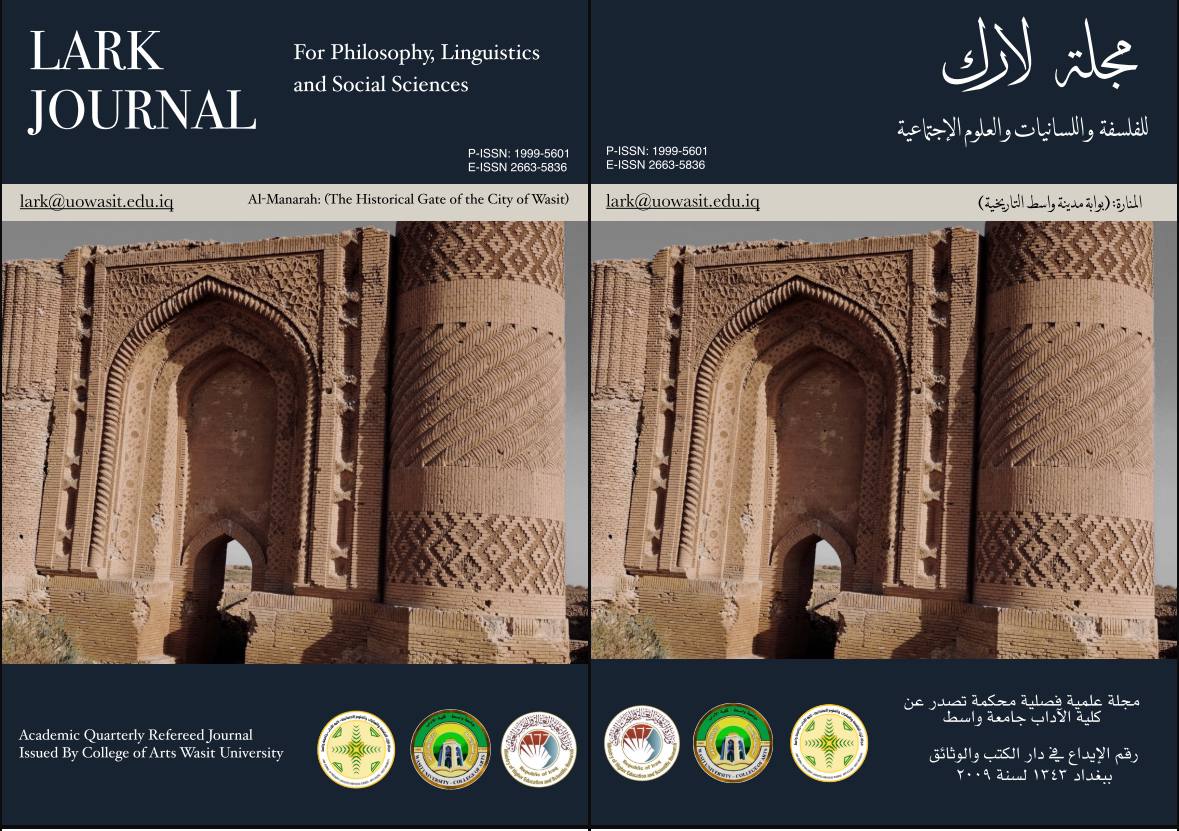The Significance of Certainty in Mahdist Anticipatory Discourse A Linguistic-Pragmatic Approach to Texts from Nahj al-Balagha
DOI:
https://doi.org/10.31185/lark.4877Keywords:
: certainty - Mahdist visionary discourse - Nahjul BalaghaAbstract
The Mahdist foresight discourse in Nahj al-Balaghah represents a unique model that combines futuristic vision with doctrinal and social analysis of the Islamic community.
The study of manifestations of certainty in this discourse relies on a profound understanding of the linguistic tools and syntactic and semantic structures employed by Imam ʿAlī (A.S.) to convey a specific message for the future. Mahdist texts in Nahj al-Balaghah are not limited to transmitting future events; rather, they create collective awareness and establish a community that is morally and doctrinally prepared for the major transformations that will accompany the reappearance of Imam al-Mahdi (A.J.).
Examining foresight-based certainty in Nahj al-Balaghah reveals a precise rhetorical mechanism that links knowledge with emotion and social action, confirming that Mahdist discourse is not merely a futuristic expectation but an educational and political instrument for reinforcing a divine future project. Accordingly, this research provides a practical model for analyzing religious texts from a ( linguistic-pragmatic perspective) , capable of uncovering the strategic depth of Mahdist discourse and its impact on shaping doctrinal, social, and political futures. This is achieved through rigorous linguistic analysis of the texts, while taking into account the pragmatic dimensions of each speech act, and comparing styles across different texts to identify recurring patterns in producing Mahdist certainty. Moreover, the study offers a linguistic-pragmatic approach to defining the relationship between language and its informative, performative, and directive functions—reflecting the profound rhetorical experience of Imam ʿAlī (A.S.) in formulating Mahdist texts.
References
1. ابن أبي الحديد. (1426هـ). شرح نهج البلاغة (تحقيق محمد أبو الفضل إبراهيم، ط. 1). دار إحياء التراث العربي.
2. البحراني، كمال الدين ميثم بن علي بن ميثم. (1362ش). شرح نهج البلاغة (ط. 1). مكتب الإعلام الإسلامي.
3. البحراني، كمال الدين ميثم بن علي بن ميثم. (1408هـ). اختيار مصباح السالكين (تحقيق محمد هادي الأميني، ط. 1). مجمع البحوث الإسلامية.
4. بديد، ياسمين حاتم. (2023). نهج البلاغة وبيانه في ما أُشكل على الصحابة من القرآن في تحديد من هم أهل البيت (عليهم السلام). مجلة لارك في الفلسفة واللسانيات، 2(48). https://doi.org/10.31185/lark.Vol2.Iss49.2936.
5. الخوئي، ميرزا حبيب الله الهاشمي. (1405هـ). منهاج البراعة في شرح نهج البلاغة (تحقيق إبراهيم ميانجي، ط. 4). المكتبة الإسلامية.
6. الشريف الرضي، أبو الحسن محمد الرضي بن الحسن الموسوي. (2004). نهج البلاغة (تحقيق صبحي الصالح، ط. 4). دار الكتاب المصري – القاهرة، دار الكتاب اللبناني – بيروت.
7. الشهري، عبد الهادي بن ظافر. (2004). استراتيجيات الخطاب: مقاربة لغوية تداولية (ط. 1). دار الكتاب الجديد.
8. الشيرازي، محمد الحسيني. (د.ت). توضيح نهج البلاغة. دار تراث الشيعة.
9. الشيرازي، ناصر مكارم. (2011). نفحات الولاية: شرح عصري جامع لنهج البلاغة (إعداد عبد الرحيم العمراني، ط. 1). دار جواد الأئمة (ع).
10. العمري، حسين. (2010). الخطاب في نهج البلاغة: بنيته وأنماطه ومستوياته - دراسة تحليلية (ط. 1). دار الكتب العلمية.
11. مغنية، محمد جواد. (1426هـ). في ظلال نهج البلاغة: محاولة لفهم جديد (ط. 2). مؤسسة الكتاب الإسلامي.
12. مهدي، نيران فالح. (2021). الخطاب الاستشرافي في خطب الجمعة: دراسة تداولية لخطب المرجعية الدينية العليا لعام 2014م. كلية الإمام الكاظم (ع).
13. يقطين، سعيد. (1997). تحليل الخطاب الروائ. المركز الثقافي العربي.ترجمة المصادر باللغة الانكليزية :
1. Al-Baḥrānī, K. al-D. M. ibn ʿAlī ibn M. (1983). Sharḥ Nahj al-Balāgha (1st ed.). Islamic Propagation Office. (Original work published 1362 SH(
2. .Al-Baḥrānī, K. al-D. M. ibn ʿAlī ibn M. (1988). Ikhtiyār Miṣbāḥ al-Sālikīn (M. H. al-Amīnī, Ed.; 1st ed.). Islamic Research Foundation. (Original work published 1408 AH).
3. . Al-Khūʾī, M. Ḥ. (1985). Minhāj al-Barāʿa fī Sharḥ Nahj al-Balāgha (I. Miyānjī, Ed.; 4th ed.). Islamic Library. (Original work published 1405 AH(
4. Al-Raḍī, A. al-Ḥ. M. ibn al-Ḥ. (2004). Nahj al-Balāgha (Ṣ. al-Ṣāliḥ, Ed.; 4th ed.). Dār al-Kitāb al-Miṣrī & Dār al-Kitāb al-Lubnānī.
5. Al-Shahrī, ʿA. H. Ẓ. (2004). Strategies of Discourse: A Linguistic-Pragmatic Approach (1st ed.). Dar Al-Kitab Al-Jadeed.
6. Al-Shīrāzī, M. al-Ḥ. (n.d.). Explanation of Nahj al-Balāgha. Dar Turath al-Shiʿa.
7. Al-Shīrāzī, N. M. (2011). Nafḥāt al-Wilāya: A Contemporary Comprehensive Commentary on Nahj al-Balāgha (ʿA. al-ʿUmarānī, Ed.; 1st ed.). Dār Jawād al-Aʾimma.
8. Al-ʿUmrī, Ḥ. (2010). Discourse in Nahj al-Balāgha: Structure, Types, and Levels – An Analytical Study (1st ed.). Dar al-Kutub al-ʿIlmiyya.
9. Badīd, Y. Ḥ. (2023). Nahj al-Balāgha and its clarification of the Quranic ambiguities for the Companions in identifying Ahl al-Bayt (peace be upon them). Lark Journal of Philosophy and Linguistics, 2 (48). https://doi.org/10.31185/lark.Vol2.Iss49.2936.
10. Ibn Abī al-Ḥadīd. (2005). Sharḥ Nahj al-Balāgha (M. A. al-F. Ibrāhīm, Ed.; 1st ed.). Dār Iḥyāʾ al-Turāth al-ʿArabī. (Original work published 1426 AH.
11. Mahdī, N. F. (2021). The Anticipatory Discourse in Friday Sermons: A Pragmatic Study of the 2014 Sermons of the Supreme Religious Authority. Al-Imam Al-Kāẓim College.
12. Mughniyya, M. J. (2005). In the Shadows of Nahj al-Balāgha: An Attempt at a New Understanding (2nd ed.). Islamic Book Foundation. Original work published 1426 AH(
13. Yaqṭīn, S. (1997). Narrative Discourse Analysis. Arab Cultural Center.
Downloads
Published
Issue
Section
License
Copyright (c) 2025 أ.م.د. حيدر كرم الله قاسم

This work is licensed under a Creative Commons Attribution 4.0 International License.





